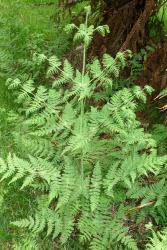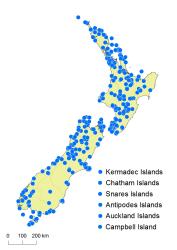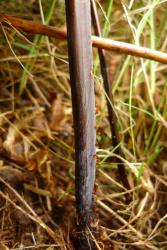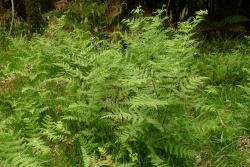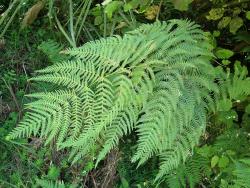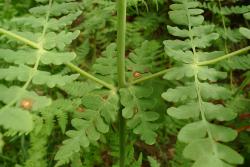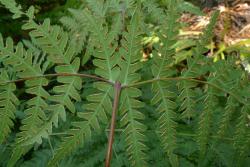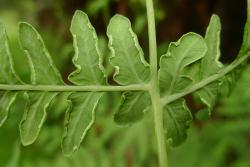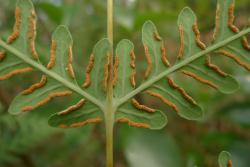- ≡ Pteris incisa Thunb., Prodr. Pl. Cap. 171 (1800)
- ≡ Litobrochia incisa (Thunb.) C.Presl, Tent. Pterid. 149 (1836)
- ≡ Phegopteris incisa (Thunb.) Keyserl., Polyp. Herb. Bunge. 51 (1873)
- = Pteris vespertilionis Labill., Nov. Holl. Pl. 2, 96, t. 245 (1807)
- ≡ Litobrochia vespertilionis (Labill.) C.Presl, Tent. Pterid. 149 (1836)
- ≡ Histiopteris vespertilionis (Labill.) J.Sm., Hist. Fil. 295 (1875)
- = Pteris brunoniana Endl., Prodr. Fl. Norfolk. 12 (1833)
- = Pteris montana Colenso, Tasmanian J. Nat. Sci. 2: 172 (1845)
Rhizomes long-creeping, 1–7 mm diameter, with stipes arising 25–130 mm apart; bearing ovate, chestnut-brown scales, 1.5–7 mm long, 0.5–1.5 mm wide, and chestnut-brown, unicellular hairs up to 2 mm long. Fronds 170–2200 mm long. Stipes 20–730 or rarely to 900 mm long, 1.5–10 mm diameter, green when young, becoming red-brown to yellow-brown, glabrous except for basal scales. Rachises red-brown proximally, yellow-brown or yellow-green distally, glabrous. Laminae usually 2-pinnate-pinnatifid to 2-pinnate-pinnatisect, rarely 1-pinnate-pinnatisect in smallest fronds and 3-pinnate-pinnatifid in the largest, ovate or elliptic, tapering to a pinnatisect apex, 110–1480 mm long, 60–1250 mm wide, glaucous when young, becoming yellow-green with age, herbaceous, glabrous. Primary pinnae in 9–16 pairs below pinnatisect apex, overlapping, sometimes narrowly winged in less divided fronds; distal primary pinnae narrowly oblong or narrowly ovate; proximal primary pinnae ovate; the longest at or near the base, 32–760 mm long, 14–260 mm wide, apices acuminate, bases usually sessile or very short-stalked in largest fronds. Secondary pinnae decreasing markedly in length along primary pinnae to the distal end, winged distally or sometimes throughout; the longest narrowly ovate, 8–185 mm long, 3–72 mm wide, apices acuminate or acute, bases sessile or adnate; the proximal pair sometimes greatly reduced in largest fronds and borne very close to the rachis. Tertiary segments ovate or oblong, 7–36 mm long, 4–11 mm wide, apices rounded, bases adnate or rarely sessile, margins entire or slightly divided on largest fronds, rarely divided more than halfway to costae. Sori ± continuous along margins of ultimate segments except at the apices.
In New Zealand, Histiopteris incisa can be recognised by its long-creeping rhizomes, glabrous and glaucous fronds (when young), presence of scales on the rhizome and stipe bases, sessile primary pinnae, reticulate venation, and sori more or less continuous around the ultimate lamina segments, protected by the inrolled lamina margins.
North Island: Northland, Auckland, Volcanic Plateau, Gisborne, Taranaki, Southern North Island.
South Island: Western Nelson, Sounds-Nelson, Marlborough, Westland, Canterbury, Otago, Southland, Fiordland.
Kermadec Islands, Three Kings Islands, Chatham Islands, Solander Island, Stewart Island, Snares Islands, Antipodes Island, Auckland Islands, Campbell Island.
Altitudinal range: 5–1320 m.
Histiopteris incisa occurs in lowland to subalpine areas throughout much of the North Island from Te Paki southwards. It ranges from near sea level to over 1300 m in the Kāweka Ranges. In the South Island it is found in lowland and montane areas throughout, becoming uncommon only in the drier inland parts of South Canterbury, Otago and northern Southland. It extends from near sea level to 1000 m on Mt Rochfort. It also occurs on Stewart Island, the Chatham Islands and all the subantarctic islands, including the Snares Islands (Horning 1983).
Throughout the tropics and southern temperate regions including Australia (Northern Territory, South Australia, Queensland, New South Wales, Victoria, Tasmania), Lord Howe Island, Norfolk Island, and almost all the main Pacific islands.
Histiopteris incisa is found in open areas, on disturbed ground and in cleared forest, in light gaps under podocarp, beech and broadleaved forest, in coastal forest and scrub, under mānuka and kānuka, in subalpine tussock and shrubland, and under introduced conifer plantations. It occurs on damp soils, dunes, and coastal cliffs, beside lakes and swamps, on roadside banks and forest margins, in ditches, on alluvial flats and river banks, on rotten logs, in wind-thrown areas, on pumice, and along thermally heated creeks and soils.
n = c. 96 (Brownlie 1961).
Perrie et al. (2015) and Shinohara et al. (2021) have shown there are two widespread lineages within Histiopteris incisa. New Zealand plants are genetically distinct from those sampled in Fiji and New Caledonia. Both lineages occur in Japan, where they are sympatric and seem to be morphologically distinguishable. Further investigation is required, including to which lineage the name Histiopteris incisa belongs.
Pteris alpina was proposed by Field (1890, p. 97) for what he thought might be a new species. He provided a description and illustration (Plate 28, fig. 2) of the plant which was "in the possession of my nephew, Mr D.H. Munro, of Christchurch who obtained it from a toll-gate keeper at the Otairi [Otira] Gorge … who collected and pressed ferns for sale to travellers". Field suggested that it might be an alpine form of Histiopteris incisa but stated that "should it prove to be new to science, I would propose to call it ‘Pteris alpina’." It is clear from this that Field did not definitely accept the species, and was simply proposing the name in anticipation of it being accepted later. Under Art. 36.1 of the Code, the name is therefore not validly published and has no status.



